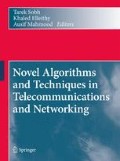Abstract
Cross-layer based approach is used in cognitive wireless networks for efficient utilization of unused spectrum by quick and correct detection of primary signals. In the current research, Su’s algorithm was modified and the RASH (Random Access by Sequential search and Hash organization) algorithm was proposed for quick detection of idle spectrum. Once the idle spectrum is detected, the Hidden Markov Model (HMM) is used to help the analysis of efficient utilization of the idle spectrum. The simulation results show that the proposed model will be helpful for better utilization of the idle spectrum.
Access this chapter
Tax calculation will be finalised at checkout
Purchases are for personal use only
Preview
Unable to display preview. Download preview PDF.
References
G. Ganesan and Y. Li, “New Frontiers in Dynamic Spectrum Access Networks”, First IEEE International Symposium on New Frontiers in Dynamic Spectrum Access Networks, 2005. (DySPAN 2005), Volume, Issue, 8-11 Nov. 2005 Page(s):137 – 143.
I. Baldine, M. Vellala, A. Wang, G. Rouskas, R. Dutta, and D. Stevenson, “A Unified Software Architecture to Enable Cross-layer Design in the Future Internet”, IEEE 2007.
C. Ghosh, B. Xie, and D.P. Agarwal, “ROPAS: Cross-layer Cognitive Architecture for Mobile UWB Networks”, J. of Computer Science and Technology, 23 (3), pp 413-425, 2008.
A. J. Goldsmith and S. Chua., “Variable-rate variable-power MQAM for fading channels”, IEEE Trans. Commun., Vol. 45, no. 10, pp 1218-1230, 1997.
L. Ma, X. Han, and C. Shen., “Dynamic open spectrum sharing MAC protocol for wireless ad hoc networks”, Proc. IEEE Symposium on New Frontiers in Dynamic Spectrum Access Networks”, 2005.
A. Hsu, D. Wei, and C. Kuo., “A cognitive MAC protocol using statistical channel allocation for wireless ad-hoc networks”, Proc IEEE WCNC, 2007.
H. Su and X Zhang., “Cross-layer Based Opportunistic MAC Protocols for QoS Provisionings Over Cognitive Radio Wireless Networks”, IEEE Jr. on selected areas in communications, vol. 26, no. 1, 2008.
J. L. Burbank and W. T. Kasch. Cross-layer Design for Military Networks. IEEE Military Communications Conference, (MILCOM 2005). Vol 3, 2005, 1912 – 1918.
S. Khan, S. Duhovnikov, et al. Application-driven Cross-layer Optimization for Mobile Multimedia Communication using a Common Application Layer Quality Metric. 2nd International Symposium on Multimedia
A. Saul, S. Khan, G. Auer, W. Kellerer, and E. Steinbach. Cross-layer optimization with Model-Based Parameter exchange. The IEEE International Conference on Communications 2007.
K. Hamdi and K. Lataief, “Cooperative Communications for Cognitive Radio Networks”, The 8th Annual Post Graduate Symposium on the Conference of Telecommunications, Networking, and Broad Casting (PG Net 2007), June 2007.
J. Unnikrishnan and V. Veeravalli, “Cooperative Spectrum Sensing and Detection for Cognitive Radio”, IEEE Global Telecommunications Conference (GLOBECOM ‘07) 2007.
S. Mishra, A. Sahai, and R. Brodersen, “Cooperative Sensing Among Cognitive Radios”, IEEE International Conference on Communications (ICC ’06) 2006.
Betran-Martinez, O.simeone, and Y. Bar-Ness, “Detecting Primary Transmitters via Cooperation and memory in Cognitive Radio”, 41st Annual Conference on Information Sciences and Systems (CISS apos 07), 14-16 March 2007 PP 369 – 369, 2007.
M. Gudmundson., “Correlation Model for Shadow Fading in Mobile Radio Systems”, Electronics Letters, vol. 27, No. 3, 1991.
A. H. Abdallah and M. S. Beattlie., “Technique for signal detection using adaptive filtering in mud pulse telemetry”, US Patent 6308562.
N. Han, S. Shon, J. H. Chung, J. M. Kim., “Spectral Correlation Based Signal Detection Method for Spectrum Sensing in IEEE 802.22 WRAN Systems”, ICACT, 2006.
Z. Ning, A. J. Cox , J. C. Mullikin., “SSAHA: a fast search method for large DNA databases”, Genome Res. 2001 Oct;11(10):1725-9.
L. E. Baum, T. Petrie, G. Soules, and N. Weiss, “A maximization technique occurring in the statistical analysis of probabilistic functions of Markov chains”, Ann. Math. Statist., vol. 41, no. 1, pp. 164–171, 1970
Paul E. Black, “Baum Welch algorithm”, in Dictionary of Algorithms and Data Structures [online], Paul E. Black, ed., U.S. National Institute of Standards and Technology. 7 July 20.
Acknowledgments
The research work was supported by Air Force Research Laboratory/Clarkson Minority Leaders Program through contract No: FA8650-05-D-1912. The author wishes to express appreciation to Dr. Connie Walton, Dean, College of Arts and Sciences, Grambling State University for her continuous support.
Author information
Authors and Affiliations
Corresponding author
Editor information
Editors and Affiliations
Rights and permissions
Copyright information
© 2010 Springer Science+Business Media B.V.
About this paper
Cite this paper
Reddy, Y.B. (2010). Cross-Layer Based Approach to Detect Idle Channels and Allocate Them Efficiently Using Markov Models. In: Sobh, T., Elleithy, K., Mahmood, A. (eds) Novel Algorithms and Techniques in Telecommunications and Networking. Springer, Dordrecht. https://doi.org/10.1007/978-90-481-3662-9_2
Download citation
DOI: https://doi.org/10.1007/978-90-481-3662-9_2
Published:
Publisher Name: Springer, Dordrecht
Print ISBN: 978-90-481-3661-2
Online ISBN: 978-90-481-3662-9
eBook Packages: EngineeringEngineering (R0)

